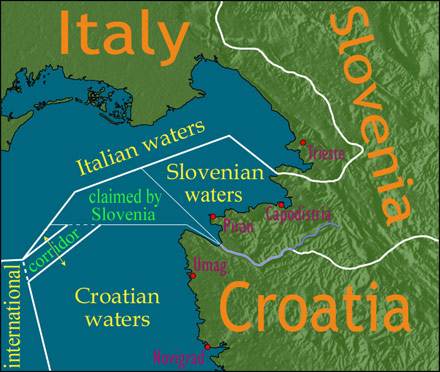Since the breakup of former Yugoslavia nearly 20 years ago, ongoing issues have dogged Croatia's progress as a nation headed towards eventual membership with the European Union. The most public of these issues was the arrest of former general Ante Gotovina [1] at the end of 2005; he is now standing trial in The Hague.
Unknown to most are more transparent issues that involve the borders of Croatia. When looking at a map, it's understandable why such issues would arise, given the twisting layout of the country. The building of a bridge [2] to the Pelješac Peninsula to bypass Bosnia and Herzegovina where it bisects Croatia in Dalmatia is one issue. Another is disputed ownership of islands [3] in the Danube River where Croatia and Serbia meet. While these items are still very much in need of resolution, it's Croatia's border with Slovenia that is posing one of its largest problems [4] due to EU enlargement considerations.
At the forefront have been the maritime issues involving Slovenia's access to the Adriatic Sea. Currently, Slovenia is seeking a corridor in the Adriatic through Croatian waters (by way of waters claimed outside their current borders), to give them access to International Waters:

Image from Wikipedia [5]
The issue is contentious, to say the least, with each side in the dispute citing historical foundation for why they're right, as was written [6] (SLV) in the Slovenija RTV forums:
- We should organize an international conference on the division of the Adriatic Sea, which has never belonged to Croatia.
– Croatia did not exist until after World War II.
– Istria has always been Slovenian.
Another border issue that is slightly less pressing in Istria [7] concerns the demarcation set by the Dragonija river, which was rerouted in Yugoslavian times. This change poses a problem as the borders of the former Yugoslavian countries were set by the Badinter Arbitration Committee [8] to be as they were while each current-day country was a state in Yugoslavia. This naturally causes strife when historical borders were placed along rivers that no longer run where they used to.
The issue of river-based borders rises again when moving to the northernmost area of Croatia. Specifically, the border formed by the Mura River creates an issue near Sveti Martin na Muri [9]. The debate surrounding this reached a troublesome point [10] in 2006, when Slovenian journalists were captured for supposedly trespassing into Croatia due to the area being contested. Again, the issue revolves around historical borders not corresponding with geographical borders and the borders as they were set at the demise of Yugoslavia. Dragutin Lesar, a member of the Croatian Parliament, writes [11] (HRV) on Nebu Išlo (“It will not go”) in more detail about the situation:
…Slovenes believe that the borders must go through the middle of the river beds Mura. […] the borders between Slovenia and Croatia (formerly part of the Republic of Yugoslavia) were identified by the old mapped boundaries of municipalities. This was the existing situation on the day of June 25, 1991, when Slovenia declared independence.
The Badinter Committee confirmed these borders as the borders newly formed States.
In addition to this, Lesar points out:
From the statement of Pogačnika Rudolf and after that meeting, it could be clearly known that Slovenia remains with about 22 disputed points on the common border between Croatia and believes that only 8 of them are controversial.
The 14 “non-controversial” points of contention with Slovenia (which include the nuclear power plant, Krško [12], that suffered a small leak last month) show that there will be continuing negotiations as Croatia gets closer to its current target date of 2010 to join the EU. Of course, frustrations rise for the Croatians as they see this date get closer, but see very few resolutions, as Hyeronimus writes [13] (HRV) on Pollitika in regards to the situation of the Mura River border:
…the Croatian public, the Croatian politics, Croatian diplomacy, the Croatian police and the government are simply silent.

Photo of the Slovenia Border Crossing in Istria from Hudin [14]
While these issues have been around for years, they had light shed on them again with Slovenia becoming part of the Schengen Agreement [15] in 2007 and the border becoming not just the border to Slovenia, but also to the EU. New issues arose out of agreements left over from both countries’ independence declarations that had to be addressed. Of course, the Slovenes and Croats are not without a sense of humor in this, as Balkan Insight reported [16] last year:
…customers in a pub which lies across the Slovene-Croat border at Obrezje, have joked that they will need their identity documents before they are allowed to go the toilet on the other side of the official border.